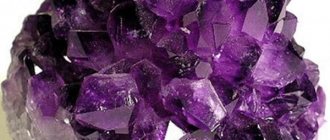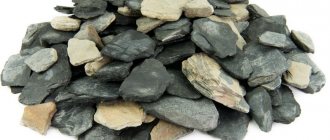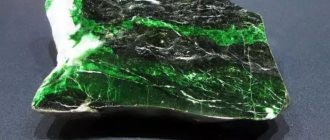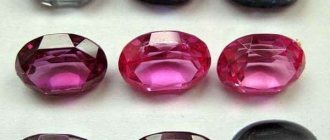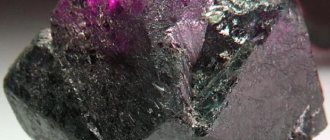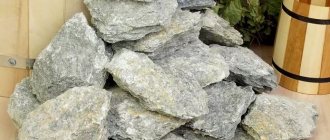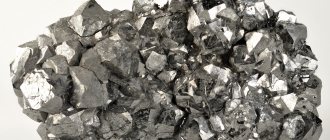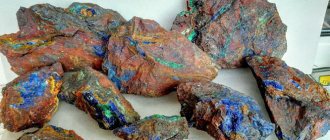Precious geodes
Not all geodes attract collectors and jewelers, but only those filled with gem crystals. They end up in museums, private collections and jewelry workshops, where they are used to make original jewelry. Geodes with amethyst crystals are most prized.
Large specimens - caves - remain in the area where they were mined as a natural attraction. Thus, in museums in Uruguay and Brazil you can see geodes that can comfortably fit an adult. They create such interesting compositions from them:
In Russia, geodes with agate, chalcedony, hematite, and amethyst are most often found; they look quite beautiful both in jewelry and in various compositions. In the Urals, geodes are called “gnarly”; here, specimens with rock crystal inside are most often found.
In Africa and Asia there are geodes with celestite, in the Alps - with calcite crystals. In the USA - with azurite.
Geodes are not only mined industrially; unusual gifts of nature are hunted by amateurs for whom communication with nature and collecting crystals is an exciting hobby that can bring considerable income. In Russia, a small geode measuring 5-7 cm with gray agate costs about 3 thousand rubles.
They check old workings and small abandoned mines using hand tools. Often luck really smiles on them, and lovers find geodes with multi-colored citrines, amethysts, rauch topazes, and rock crystal.
How and where geodes form
We figured out how and where geodes do not form. Now, let's move on to the places and conditions where the formation of cavities with crystals is possible. In igneous rocks, a quartz geode is most often a gas bubble. Rising from the depths of the earth, magma, as is known, seethes.
Hot rocks are saturated with gases, which often collect in bubbles. The magma cools and solidifies around them. This is why most basalt and granite geodes have a round shape. Gas pressure is known to be uniform. Therefore, the bubbles retain spherical contours.
Geodes in sedimentary rocks, on the contrary, are often irregular in shape. Voids are formed during the process of compaction, washing out of rocks, and cracking.
Typical sedimentary ones include, for example, simbircite geodes . Simbircite is an ornamental stone found in the Ulyanovsk region.
The mineral is a type of calcite, but is based on golden marble onyxes. The filling of geodes depends on the intensity and saturation of the flow of mineral waters. As a rule, salts of various substances are dissolved in them.
Affects the internal “decoration” of voids and their age. If a rock crystal geode takes millions of years to form, even a weak mineral flow will have time to form an abundance of crystals.
Therefore, there are voids that are not voids at all, with a solid semi-precious mass. This is the result of the accretion of aggregates in a limited space.
Mineral solutions continue to flow and will be converted into crystals as long as there is free space. When the geode is completely filled, the flows begin to bend around it.
Healing properties of the stone
The healing properties of agate will best manifest themselves when worn directly on the body. A pebble in the form of a keychain is unlikely to become a talisman or amulet for its owner. Therefore, wear it in such a way that there is contact with the skin. For men, a ring is the best option, while for women, agate earrings or a bracelet are perfect.
For agate to show its healing properties, contact with the skin is necessary.
The properties of an agate stone depend not only on what type of mineral was chosen, but also on how it is worn and used:
- a ring on the middle finger of the right hand will help you forget about nervous breakdowns and relieve insomnia;
- a stone placed on the stomach will relieve symptoms of nausea and improve the functioning of the gastrointestinal tract;
- placed in the heart area, will heal from ailments associated with this organ;
- when fixed in the neck area, the pebble will begin to heal the throat and oral cavity;
- placed on the eyes, it can improve vision, cope with cataracts and glaucoma.
Let the talisman rest and be sure to clean it. After all, sooner or later he will absorb too much negative energy and stop absorbing it. To prevent this, leave the amulet in a glass of salt overnight and rinse it under running water in the morning.
Origin
How do you get a shell filled with crystals?
- Cracks of different sizes form in the earth's crust. Most often this occurs due to volcanic eruptions.
- Moisture then penetrates into this closed space, forming a precipitate of salts.
- After many years, the sediment begins to turn into crystals.
- Thus, different types of gems grow in the crack cavity, which simultaneously form several layers. There are also specimens that appear not only on land, but also on the bottom of the oceans.
You can find a geode in the same place where other precious crystals are mined. Most often, such objects are found in Southeast Asia, India, Australia, Sri Lanka, etc. On the territory of Russia, cavities with gems can be found in the Urals. The sizes are directly related to the area in which geodes are found. The largest specimens were discovered in Brazil. Their size allows a person to climb inside to his full height. Also, their “filling” in the form of gems depends on the place of extraction.
The cost of geode products depends on its dimensions and the types of gems that are inside
Processing process
After finding a cavity with nuggets, it is processed so that it acquires a presentable appearance. How does this happen?
- First, the shell is cleaned using a special solution.
- Next, the find is sawed up. This stage requires a lot of effort, since the crystals cannot be damaged.
- Then the processing is completed by leveling the surface and polishing.
Components of GIS
A working GIS has five key components: hardware, software, data, people, and methods.
Hardware.
This is the computer running the GIS. Today, GIS operate on different types of computer platforms, from centralized servers to stand-alone or networked desktop computers.
Software
A GIS contains the functions and tools needed to store, analyze, and visualize geographic (spatial) information. The key components of software products are: tools for entering and manipulating geographic information; database management system (DBMS or DBMS); tools to support spatial queries, analysis and visualization (display); graphical user interface (GUI or GUI) for easy access to tools and functions.
Data.
This is probably the most important component of GIS. Spatial location data (geographic data) and associated tabular data may be collected and produced by the user or purchased from vendors, commercially or otherwise. In managing spatial data, a GIS integrates spatial data with other data types and sources, and can also use the DBMSs used by many organizations to organize and maintain the data they have.
Performers.
Widespread use of GIS technology is impossible without people who work with software products and develop plans for using them to solve real problems. GIS users can be both technical specialists who develop and maintain the system, and ordinary employees (end users) to whom GIS helps solve everyday affairs and problems.
Methods.
The success and efficiency (including economic) of using GIS largely depends on a properly drawn up plan and work rules, which are established in accordance with the specific tasks and work of each organization.
Application area
Agate jewelry, amulets, carved seals, gems, figurines, vases and vessels were popular among ancient peoples around the world. Artifacts found by University of Cincinnati archaeologists in 2015 during the opening of a rich tomb in the Peloponnese included ivory combs inlaid with agates and a carved agate seal. The miniature drawing, skillfully carved on the surface of the stone seal, is a scene of a mythological or real battle. Some details of the image can only be seen under a microscope. A unique archaeological find challenges our understanding of the level of artistic excellence of the Aegean era.
During archaeological excavations in the City of David (the oldest area of Jerusalem), among the ruins of a temple burned during the conquest of the city by Nebuchadnezzar's wax, a seal was found, skillfully carved on an agate base. The estimated age of the archaeological find is 2600 years.
Beads, bracelets, brooches, cufflinks, earrings, rings, pendants, pendants - original jewelry with agates has been and will be popular at all times. A hard but viscous mineral with its unique, never repeating pattern, is used for mosaic panels, the manufacture of facing tiles, and countertops. Modern life is decorated with agate figurines, vases, boxes, business card holders, and key rings.
Homogeneous agates are in demand as a technical stone:
- in precision instrument making (for the manufacture of analytical balances, watch stones);
- in textile production (thread guides);
- for the manufacture of extrusion equipment (dies);
- for the manufacture of mortars and pestles, which are used in chemical analytical laboratories and artists' workshops.
Quartz geode
An amethyst geode can be of any size: from “almonds” with a diameter of less than 1 cm to meter-long giants whose weight can exceed 100 kg. The crystals inside it can be either pointing inward or located completely chaotically. Sometimes there is an empty space in the center of the geode, and there may be holes on the surface.
The largest deposits of amethyst geodes are located in the countries of South America and Africa. They are formed in the form of deposits of crystals, which, accreting, become covered with a dense crust, reminiscent of scale.
Precious and semi-precious stone geodes are used in jewelry and are also collectibles. The amethyst geode is one of the most popular. In Brazilian and Uruguayan museums you can find amethyst geodes with a diameter exceeding human height. Amethyst druses are also extremely popular as home decoration. They are believed to have powerful mystical properties.
Magic properties
Even in Ancient Egypt, they noticed the benefits of stone for women. It was considered a symbol of family and motherhood. In the Middle Ages, with its help they achieved complete well-being. In addition, there are a number of other abilities of magic gems:
- protect from unnecessary, thoughtless purchases;
- force you to think rationally without indulging in fantasies;
- indicate the right path to achieve your goals;
- dampen negative energy;
- allow you to achieve spiritual growth;
- forced to make decisions and act;
- protect from the evil eye and damage.
This effect is achieved regardless of whether the mineral is used as a talisman, processed or unprocessed. An agate geode is even used in magic.
The magical properties of a gem directly depend on its color:
white – protects against dark forces, is considered a source of health;
blue – gives inspiration, love, teaches a person to express his feelings and thoughts, relieves fear and anger;
yellow - considered a talisman for merchants and travelers, protects against risky contracts, makes the journey easy and pleasant;
yellow-brown - helps in communicating with influential people to win them over to your side;
green – great for meditation, helps in decision making and problem solving;
golden – gives vitality, gives inspiration;
gray-brown - helps to achieve rapid career growth, increases efficiency;
red – helps achieve harmony in family relationships;
pink – relieves emotional distress, pacifies;
gray – prevents conflicts, protects from ill-wishers;
blue – helps set goals and contributes to their achievement;
purple – gives the ability of clairvoyance;
black - makes it possible to concentrate, concentrate attention.
Mystical properties
The magical properties of amethyst druse are great. Some people are sure that amethyst is the same legendary alatyr stone. It is believed that both jewelry made from it and parts of the geode located in the house help a person.
Here are some types of influence of amethyst on a person:
- gaining wisdom, vitality;
- opening new paths and opportunities;
- cleaning living space;
- protection from the effects of black magic;
- assistance in solving psychological and spiritual problems;
- strengthening family ties;
- protection from physical violence, murderers, thieves.
It is believed that the mineral itself chooses its owner. To understand whether this stone will help you, you need to pick it up and listen to your feelings. You will clearly understand whether he wants to see you as his owner or not. Amethyst patronizes Sagittarius, Pisces, Scorpios, but is often not suitable for Libra and Capricorn.
Druza helps the home, couples, and families. It cleanses the home of negativity brought by other people, strengthens feelings and protects against adultery. Amethyst is also a powerful amulet against drunkenness. It is useful to wash children with amethyst water - it calms the nerves and helps to absorb new knowledge. To present a friend as a gift to a young family means to sincerely wish her happiness and eternal love.
How to clean such an assistant from the negativity that has accumulated in him? After a quarrel or feeling unwell, the crystal should be washed with cool running water and then left for several hours in a place where it will be illuminated by the moon. This stone is saturated with the light of the moon, and not the sun, which can damage the very essence of the mineral.
Also, the magic of the stone strengthens mental abilities, memory, promotes the development of intuition, strong character, and talents.
Amethyst products have a particularly good effect on people who practice meditation. They promote clarity of mind and psyche, cleans the room, thereby helping the free passage of energy flows. Also, the stone is the best assistant for fortune telling, the development of clairvoyance, and witchcraft powers. The strongest magical properties of druzes contribute to the acquisition of mystical knowledge, a special gift that is not given to every person.
Properties
The healing properties of agate geodes depend on the shade of the stone itself:
- White improves health, accelerates the healing process of soft tissues, as well as bone healing in case of fractures.
- Gray agates help get rid of heart disease, heal arthritis and other joint diseases.
- Blue strengthens the immune system, helps cure throat diseases, skin diseases (especially eczema). Helps get rid of stuttering and calms nerves.
- Brown has a beneficial effect on vision, prevents kidney disease, and normalizes the functioning of the digestive system.
- Yellow agate has an antipyretic effect on the body and normalizes body temperature.
- Pink is a protector against colds and frequent ARVI. It copes with prolonged cough and constant sore throats.
- A black agate geode treats complex disorders of the nervous system.
- Green strengthens the immune system, increases the level of hemoglobin in the blood, and removes toxins from the body.
As for other varieties of agate, for example, moss, eye, fire, landscape and others, it is important to determine which shade predominates in the stone, and only from this point of view to analyze its medicinal properties. Geodes filled with crystalline agate druses are the most valuable not only for collectors, but also for magicians, psychics and hereditary sorcerers
Education is used as a tool in various magical rituals. With its help, they attract financial well-being, good luck in business and in their personal lives. In addition, if you have an agate geode at home as a talisman, then, regardless of the shade, it will help maintain mutual understanding in the family, avoid adultery, quarrels, scandals, and also protect your home from thieves and even fire
Geodes filled with crystalline agate druses are the most valuable not only for collectors, but also for magicians, psychics and hereditary sorcerers. Education is used as a tool in various magical rituals. With its help, they attract financial well-being, good luck in business and in their personal lives. In addition, if you have an agate geode at home as a talisman, then, regardless of the shade, it will help maintain mutual understanding in the family, avoid adultery, quarrels, scandals, and also protect your home from thieves and even fire.
Types of geodes
Voids that occur within sedimentary rocks are located in nodules. A concretion is a round formation resulting from the growth of crystals.
Crystallization is not always uniform, so not every nodule has a spherical shape, but all of them have a radial structure. A geode occurs as a consequence of changes in the crystals within the nodules.
There are also geode voids of recrystallization. This happens when the already grown crystals dissolve again, the crystallization process starts again. But, since the concentration of minerals is no longer so high, and the impurities washed out by groundwater are not renewed, a void gradually forms in the enclosed space of the nodule.
Limonite geode is also not uncommon. This formation occurs due to the oxidation of iron ore rocks found in nodules.
Quartz nodules are often found in limestone and chalk rocks. Geodes filled with precious stones are often found in them. Of course, such finds are of particular interest to gem lovers. Precious crystals of amethyst and other stones often form druses.
Metasomatic geode objects arise due to the incomplete replacement of some mineral formations by others. They do not represent any jewelry or aesthetic value, but are very important for scientific research. Such a geode helps to better understand the processes that occur in sedimentary rocks.
Education mechanism
A popular division depending on the method of formation:
- Metasomatism. One mineral is partially replaced inside the cavity by another. It is of interest to scientists as a marker of processes occurring in the deep layers of the earth’s crust.
- Recrystallization. Natural disasters trigger the process of destruction of already formed crystals. Thermal waters wash out impurities from this viscous mass. The “pure” residue begins to crystallize again. The result is a transparent filling, without inclusions, cloudiness or other flaws.
The latter variety is especially valued by jewelers.
Compound
The species is determined by the main mineral in the composition:
- Limonite. Formed in iron ores. Water, filling cavities or cracks, oxidizes them, forming “geodes”.
- Silica. Found in limestone cavities. More often, a druse of quartz is hidden inside.
- Ferromanganese. Formed on the sea or ocean floor.
A special type is simbircite geodes. These are fossilized shells of ammonite mollusks that became extinct millions of years ago (which is why geodes are often called ammonite). Filled with marble simbircite or pyrite.
Dimensions
Geode dimensions are generally average – from a few to a couple of tens of centimeters.
The smallest (up to 1 cm) are called tonsils, the largest are called caves. "Caves" can exceed human height.
Color
The color is determined by the composition of the base minerals.
Thus, the often found amethyst geode has a rich purple hue, while specimens with citrine are yellow-green.
Agate samples are not crystalline and are identified by alternating reddish-brown and white-gray or blue and pink layers.
Form
In nature there are fragments of different shapes. Most often these are oblate spheroids.
The rarest but most valuable is the correct sphere.
Varieties of agate
Types of agate stone vary in shape, color, and pattern. Multi-colored layers on a cut of an inconspicuous-looking mineral create a variety of patterns of stunning beauty. Agate stripes follow the uneven contour of the cavity where the gem hardened. The composition and structure of the mineral are characterized by great variability.
Agate geode, amethyst crystals
If the voids of an agate geode are filled with crystals of quartz, amethyst, and rock crystal, they are located perpendicular to the surface of the individual layers. Among the numerous types of natural agate stone, there are samples where several thousand different layers and inclusions can be seen on one square centimeter under a microscope. No two identical stones can be found in nature.
Colors
The agate palette includes a wide range of colors, tones, shades. But the minerals of one deposit have one dominant color. Other colors on the cut, complementing and enlivening the stone design, appear due to the inclusion of impurities. Agate (banded chalcedony) in the absence of impurities is bluish-gray, white-gray, white-blue. Color contrasts are created by the presence of thin chalcedony layers of varying hardness and porosity, which scatter light differently.
Banded chalcedony
Red, pink, orange-red, brown-chestnut, yellow tones and shades of agate layers are created as a result of the inclusion of iron, its oxides, and manganese oxide. The green color appears under the influence of silicates. The intensity and shades of color are determined by the amount of mineral impurities.
Mineral with inclusions of goethite and hematite
Patterns
Agate is classified by its pattern on the cross section. There are more than a hundred varieties of gems.
The most common:
- striped - a ribbon pattern forms parallel stripes, concentric - closed (the contrasting boundaries of the stone pattern are characterized by a change in the composition of minerals or the concentration of an impurity mineral solution, which determines the formation of the mineral);
- bastion (fortification) - a design reminiscent of an impregnable fortress wall, created by a bizarre play of parallel-concentric stripes with sharp angular bends;
- fiery (flaming) - the ability to emit a natural glow appears due to diffraction and refraction of light flows passing through iron oxides, thin layers of chalcedony, air-filled voids;
- mossy, dendritic, landscape, floral - this group does not have a characteristic banded layering, green-brown mossy, fern-like or brown-black patterns, similar to branches, tree crowns, grass, are created in the thickness of chalcedony by large inclusions of chlorite, goethite, celadonite, oxide manganese;
- ocellar (spectacle) - distinguished by a characteristic circular pattern with a dot in the center, reminiscent of the eye pupil;
- star (star-shaped) - these are corals replaced by agate, a large star is clearly visible on the stone cut;
- lace—an elegant pattern imitates the finest carved lace;
- carnelians (carnelians), sarders - orange-red-brown, chalcedony with a concentric-banded texture;
- sardonyx - orange-red or brown chalcedony minerals with a linearly banded texture and white opaque zones;
- onyx is a type of striped agate with alternating black and white layers.
Sardonyx
Rich deposits are found on the Deccan Plateau (Indian Peninsula), in Brazil, Uruguay, Mexico, North America (Bay of Fundy, Graham Island, in the vicinity of Deerfield, Massachusetts), South Africa, Russia (Eravninsky Lakes, confluence of the Bureya and Zeya rivers, on the Amur River, Chukotka, in the northern zone of the Timan Ridge). The once world-famous deposits of Idar-Oberstein (Germany, Rhineland-Palatinate), which were famous for natural pink, red, brown agate, are now depleted.
Education
A geode can form quite quickly. This occurs when crystals grow rapidly inside a closed space, often cavities in the array. The minerals inside such formations do not necessarily become crystals; sometimes they are deposited on the walls of the nodule, building up layer by layer. Such finds look very beautiful in cross-section.
Voids, of course, are not only made of amethyst; they are very different in their composition. Mineral deposits in bubbles and cracks in earth rocks occur due to proximity to hydrothermal vents. And, if in ancient times Pliny described formations with clay inside, then in our time mineralogists value nodules with crystals.
Underground water with minerals dissolved inside, getting inside the air bubble, gradually dries out, due to which the concentration of salts increases, and the crystallization process begins. Most often, crystals from substances found in mineral waters are found inside the voids. Calcium, silicon, barium, sulfur, etc. are most often found by mineralogists inside nodules.
On the topic: Properties of green amethyst (magical, healing). Zodiac signs
Physical properties of rocks, scope of their application
Physical properties of rocks are internal features that characterize a particular rock, explaining its difference or commonality with other rocks and manifesting itself in the form of a response to the influence of external physical fields or environments.
The numerical expression of the physical property of a rock is dimensional or dimensionless parameters in the form of a coefficient, indicator, characteristic, that is, a quantitative measure of this property.
There are scalar and tensor physical parameters of materials. Due to the diversity of mineral composition, structures, multiphase, and genesis, rocks have a wide range of physical properties. Over the course of many years of study, it was possible to determine standard methods for measuring the physical properties of rocks, indicating the composition and structure of the material.
In rock physics, a classification has been adopted that identifies the main groups of physical properties, depending on the type of external physical field:
- dense;
- mechanical;
- thermal;
- electrical;
- magnetic;
- wave;
- radiation;
- hydrogasdynamic.
Using basic independent physical parameters, different rocks are compared, jointly considered and analyzed. These characteristics include:
- volumetric mass;
- porosity;
- compressive strength;
- tensile strength;
- longitudinal modulus of elasticity;
- coefficient of relative transverse deformations;
- coefficient of thermal conductivity;
- specific heat;
- coefficient of linear thermal expansion;
- electrical resistivity;
- relative dielectric constant;
- relative magnetic permeability.
A rock passport for physical properties is a unified digital record of the basic physical parameters of a particular rock. Basic parameters are required to be determined and are the general foundation in science that studies all rocks.
Changing one physical parameter of a particular material in any way entails an increase or decrease in the value of other characteristics. The relationship between the physical properties of rocks allows us to determine other parameters based on the available data.
Rocks for modern humanity have primarily applied, utilitarian significance. But the decorative qualities of many natural resources are also highly valued. In the economic complex, natural materials are used in various areas of human activity.
Rocks are of great importance for industry and other areas:
- Iron, titanium, vanadium, nickel, copper, sulfur are extracted from gabbro, and pyroxenites serve as a source of iron and platinum.
- Granite, marble, basalt are used as decorative finishes, brick and concrete are popular building materials.
- Roads, highways and sidewalks are made from crushed stone, concrete, and bitumen.
- Coal, peat, and radioactive raw materials are used as an energy source.
- Sand and sandstone are used to produce glass, sand-lime brick, concrete, and road surfaces.
- Dolomite is one of the components in the production of rubber, porcelain, and earthenware.
- Hydrochloric and acetic acid, acetylene, caustic soda, calcium carbide, and cement are made from limestone.
What is a druse
Drusen is a crystal formation that occurs naturally. The name is translated from German as “brush”.
Such units look like a work of art. Therefore, they are often used in their original form, without cutting into individual elements. Depending on the size of the formation, it is used as an interior item or part of jewelry.
In a druse, the crystals are always of the same type. The base on which they grow may be another mineral or metal. It depends on the breed.
Often the crystals in a druse are directed in different directions. This makes the shape look like a flower. Mineral build-ups form in rock cavities. The process of their growth is similar to the development of a pearl:
- The germs of stones settle on the base. Usually it is played by cracks in other mineral rocks.
- In an involuntary order, the embryos begin to grow, acquiring a geometric shape.
- During growth, the crystals come into contact in different places. In this case, some of the gems (growing perpendicular to the base) grow together, and some (located at an angle) stop growing.
Drusen take years to form. In the process, cracks and chips form on some of them, and some elements become bent. That is why beautiful growths of gems are so highly valued.
The walls of many precious geodes are made of drusen. In turn, geodes are burrows - spherical formations, the inner walls of which are covered with a group of crystals. They are often irregular in shape. They are usually used to create jewelry and costume jewelry.
According to esotericists, druse is a symbol of harmony. It consists of individual gems fused together. It is believed that if you put it at home, the family will forget about serious quarrels and problems.
Watch the video to see what a huge druse of stones looks like:
Types of drusen
Drusen are classified according to several parameters. First of all, this is the type of mineral from which it is composed. The list contains gems that grow together into aggregates more often than others:
- amethyst;
- Moonstone;
- citrine;
- morion;
- aquamarine.
Drusen are divided into varieties depending on shape, size and color:
- Flower. Large gems with a common base, growing in different directions.
- Brush. A large number of fused small crystals.
- Geodes. Crystals form on the inner cavity of the spherical formation.
The shape of fused gems can be different: cubic, hexagonal, triangular.
What is a geode
A cave is a cavity near the surface, connected to it by one or several exits. In other words, you can go into the cave and climb down using belay. A geode is a body closed on all sides.
It is similar to the Earth because it has a spherical shape. Mineral rings are deposited on the walls, like geological layers in the earth's crust.
These are deposits from solutions that seep through the surrounding rocks. The composition of the water changes, and the color of the mineral rings also changes. As a rule, they are composed of chalcedony, that is, a cryptocrystalline variety of quartz.
It turns out that an agate geode , or any other, is the result of sedimentary processes.
Layers of cryptocrystalline minerals are deposited on the walls of a round cavity in the earth's crust, and then, as a rule, crystals appear.
They can completely fill a geode. But more often than not, the central part remains empty. Essentially, if you chip away at the edge of a large geode, for example during excavation, you create a cave.
In order not to confuse the concepts, many mineralologists introduce a size scale. Cavities from 1 centimeter to a meter in diameter are geodes, larger formations are caves. However, not everyone agrees with this division. Otherwise, the Cave of Crystals in Ohio would not be considered the largest geode in the world.
How to distinguish real agate from a fake
Before buying, people usually try to find out how to distinguish an original from a fake. Agate does not cost exorbitant amounts of money. However, this does not prevent deceivers from profiting from buyers by passing off plastic or glass as natural stone.
In pursuit of money, dishonest sellers are ready to deceive even small amounts. In order not to fall for the bait of these scammers, you need not only to know what an agate stone looks like, but also to be able to understand whether the price of the product corresponds to its quality.
How to do it:
- Products with agate are quite heavy. Plastic is known for its lightness, so counterfeits made from this material are very easy to identify. Glass will weigh more, but pure mineral is still heavier. It’s easy to feel the difference between them if you’ve already held a mineral in your hands before.
- Another way to check its natural origin is to run a needle across the surface. Nothing will happen to the natural stone, but a mark will remain on the fake.
Igneous rocks
This group of materials represents the final products formed as a result of magmatic activity, during the solidification of magma and lava. When a natural melt transitions into a solid state of aggregation, substances crystallize. Igneous rocks are of great importance to the earth's crust. They form geological bodies that differ in shape and size, composition and structure. Magmatites are found in large quantities in shields, platforms, orogens, and oceanic crust. About 90-95% of the upper layer of the earth's crust, which is approximately 16 kilometers, is represented by igneous and matamorphic rocks. Approximately 15% of the solid surface of the planet is occupied by igneous rocks.
Origin
Igneous rocks are located near active or long-dormant volcanoes. These materials originated from lava eruptions and are found both on land and in water.
They consist of a mixture of components:
- volcanic ash;
- slags;
- pumice;
- volcanic bombs.
How are geodes mined?
A geode with crystallized amethysts or other gems inside is a highly valuable object that is especially coveted by mineral and gemstone collectors. Geodes are not mined on an industrial scale, as is the case with regular gemstones. Such semi-precious voids are often deliberately sought by scientists or simply hobbyists who are passionate about their work.
At the same time, experienced specialists check not only new discovered deposits, but also old mines at any depth. The search for precious formations occurs virtually by hand and by touch. The only thing you can rely on here is intuition, and not geological exploration knowledge. The seeker relies only on luck and his own experience in searching for nodules.
During the search process, entire layers of rocks are sifted, river sediments are excavated and mineral veins are examined. However, there are no guarantees that a geode found with great difficulty will not turn out to be with ordinary quartz, and not with amethysts or citrines. We can say that the search for such jewelry is a real lottery.
